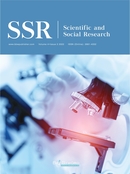Abstract
As China is undergoing rapid urbanization and social transformation, the research on urban poverty has become increasingly important. So far, the Chinese government has still not drawn an official urban poverty line. The statistical measurement of the overall scale of urban poverty in China is carried out based on three aspects: price adjustment, income distribution data, and main poverty-stricken population, in which the trend analysis of the poor population, the maximum likelihood estimation, and the recent price adjustment are used as measures. The arithmetic average of the urban poverty population, measured via the above three different measures, is taken to obtain the current overall scale of urban poverty in China, which is 10.816 million.
References
Chen Z, 1993, The Theory and Practice of Poverty Reduction in the Public Economy. Nankai Economic Research, 1993(06): 10-20.
Li S, Knight J, 2002, Three Types of Poverty in Urban China. Economic Research, 2002(10): 47-58, 95.
Hussain A, 2013, Urbanization: Benefits and Policy Challenges, Beijing Forum (2013) Harmony of Civilizations and Shared Prosperity – Looking Back and Looking Forward: “Urbanization: Planning and Diversity for Sustainable Development” Sub-Forum V A Collection of Papers and Abstracts, [publisher unknown], 18-19.
Chen Z-S, Yu T, 2017, Poverty Line, Poverty Rate and Problems in Urban China. Comparative Economic and Social Systems, 2017(06): 40-53.
Wang Y, 2006, Evaluation of the Implementation of Urban Residents’ Minimum Living Security Policy. Statistical Research, 2006(10): 49-54. DOI: 10.19343/j.cnki.11-1302/c.2006.10.011
Wang N, Wei H, Su H, 2016, Reflections on Urban Poverty Standards in China in the New Era. Jianghuai Forum, 2016(04): 32-39. DOI: 10.16064/j.cnki.cn34-1003/g0.2016.04.006
